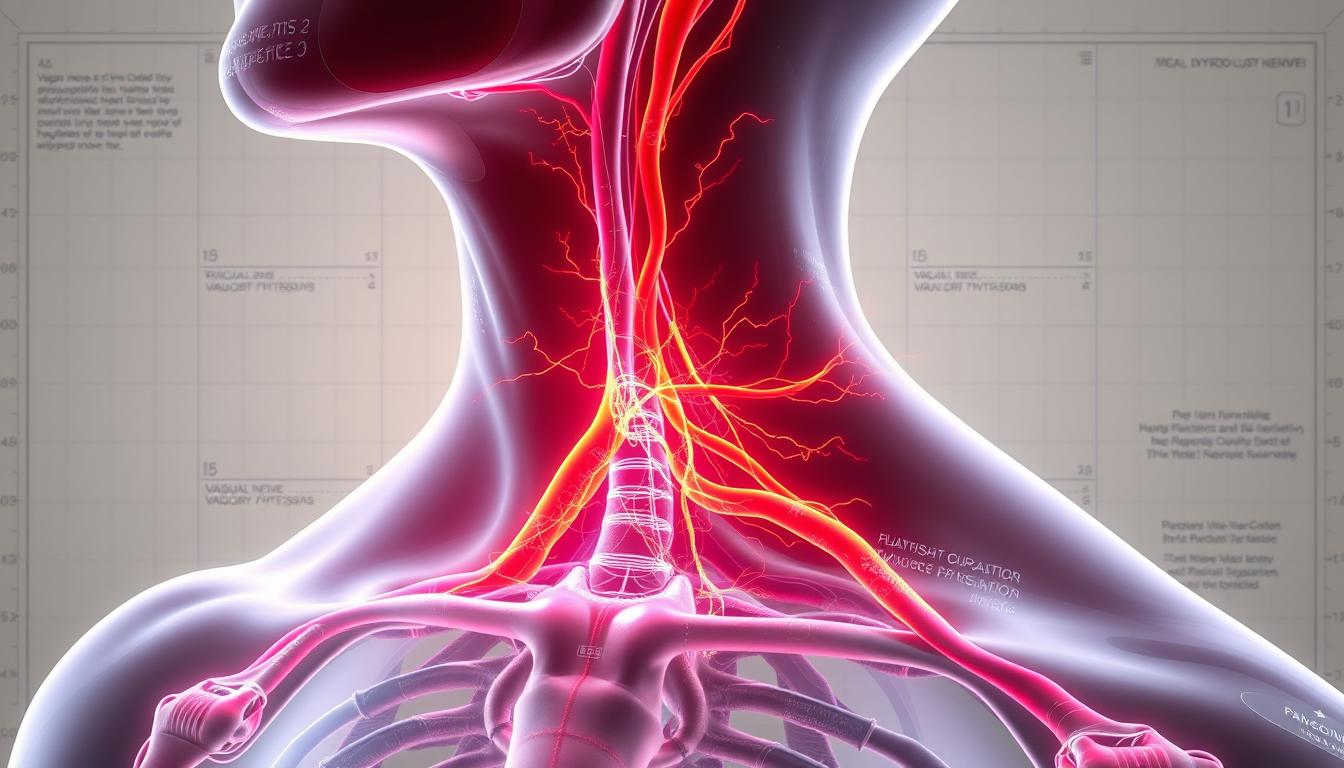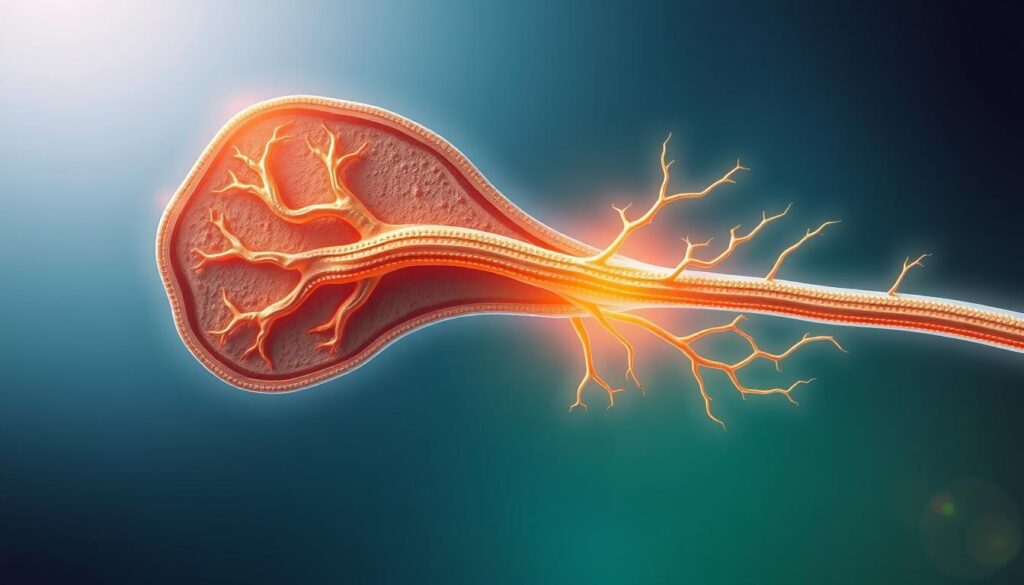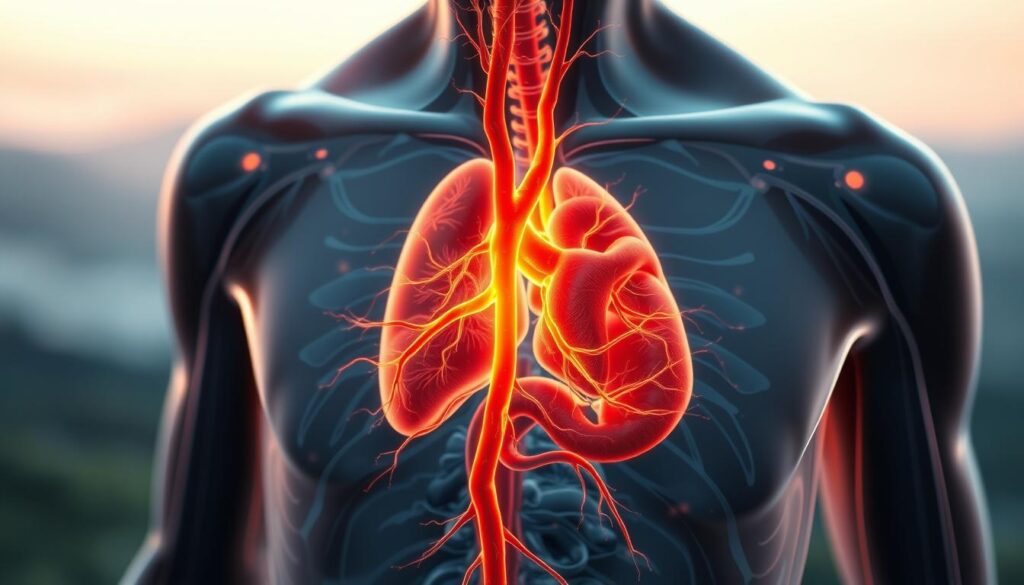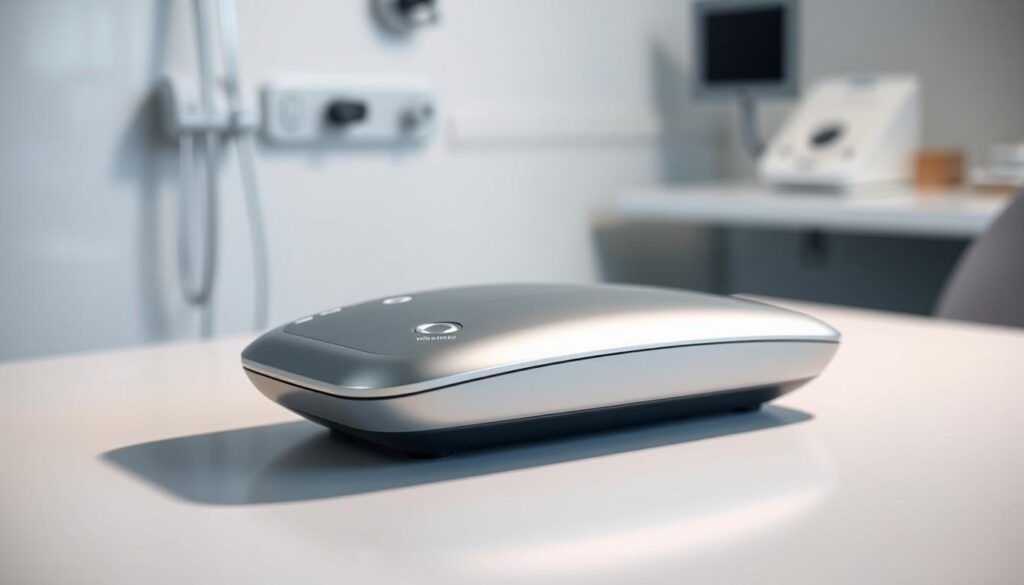Vagus Nerve Stimulation: Unlocking the Power of Your Body’s Control Center
Discover the power of Vagus Nerve Stimulation and how it can unlock your body’s control center.

Did you know one of the 12 cranial nerves controls many bodily functions? The vagus nerve is key in the parasympathetic nervous system. It runs from the brain stem to the gut.
The vagus nerve is a major part of your body’s control center. It helps manage many physiological processes. Learning how to stimulate this nerve can boost your health and happiness.
Key Takeaways
- The vagus nerve is a critical part of the parasympathetic nervous system.
- It plays a key role in controlling heart rate, digestion, and other bodily functions.
- Stimulating the vagus nerve can have a positive impact on overall health.
- The nerve extends from the brain stem to the gut, influencing various physiological processes.
- Understanding vagus nerve stimulation can help you unlock the power of your body’s control center.
The Vagus Nerve: Your Body’s Hidden Control Center
The vagus nerve is a key part of your body. It helps control many functions. It runs from your brain to your large intestine.
Anatomy and Function of the Vagus Nerve
This nerve does a lot, like controlling your heart rate and mood. It also helps with urine output. It’s part of your parasympathetic nervous system, which helps you relax.
The nerve has both sensory and motor fibers. This lets it send and receive signals to and from your body. For more details, check out studies on PMC.
Why Scientists Call It the “Wandering Nerve”
Scientists call it the “wandering nerve” because it reaches far and wide. It doesn’t just stop at one place. It goes through your neck, thorax, and abdomen.
This makes it a key way for your brain to talk to your body. It affects many areas, including:
- Heart rate regulation
- Digestive processes
- Mood modulation
- Respiratory control
What Is Vagus Nerve Stimulation and How Does It Work?
Vagus nerve stimulation sends electrical impulses to the vagus nerve. This nerve is key for heart rate, digestion, and breathing. It’s used to treat conditions like epilepsy.
A device, called a vagus nerve stimulation device, is implanted under the skin. It’s usually in the chest. This device sends electrical impulses to the vagus nerve regularly.
The Science Behind Neural Stimulation
The science of vagus nerve stimulation is about changing neural pathways. It can affect mood, seizure control, and more. Studies show it helps those with treatment-resistant depression and epilepsy.
For more on VNS, check out Cleveland Clinic’s Vagus Nerve page.
From Medical Treatment to Wellness Approach
Originally for medical use, vagus nerve stimulation is now seen as a wellness tool. It helps with stress, sleep, and brain function. As research grows, VNS is used more for wellness than just treating diseases.
Breaking News: Latest Vagus Nerve Stimulation Research
Recent studies have shown the huge promise of vagus nerve stimulation (VNS) in treating many health issues. As research keeps growing, doctors are seeing a big change in how VNS is used.

Recent Clinical Trial Results
Clinical trials have found that VNS works well for treating depression and epilepsy that doesn’t respond to other treatments. The latest results show that patients with these conditions see big improvements with VNS therapy.
These trials show a clear drop in symptoms, with some patients even getting better completely. This is a big step forward for VNS as a treatment option.
New Applications Being Investigated
Research is also looking into VNS for other health problems like multiple sclerosis, migraines, and Alzheimer’s disease. Early results are encouraging, showing VNS could bring new hope to those suffering from these conditions.
As scientists keep studying VNS, they’re finding new uses for it. VNS therapy is becoming a hot area of research, with its uses expanding beyond what we know now.
The future of VNS is looking very promising. With more studies, we’ll learn even more about its benefits. This will open up new ways to help patients get better.
Health Benefits of Vagus Nerve Stimulation
Vagus nerve stimulation offers many health benefits. It helps manage epilepsy and even depression. This therapy is showing great promise for many people.
VNS works by sending electrical impulses to the vagus nerve. It helps control abnormal brain activity. This improves overall health and well-being.

FDA-Approved Medical Applications
The FDA has approved VNS for treating epilepsy, depression, and headaches. For those with epilepsy, it can lower seizure frequency. It also helps improve mood and mental health in depression.
VNS is also used for migraines and cluster headaches. It can reduce how often and how severe these headaches are.
Emerging Benefits Under Investigation
Researchers are looking into VNS for more uses. They’re studying its effects on anxiety disorders, post-traumatic stress disorder (PTSD), and inflammatory conditions.
Some early results show VNS might help heart health by lowering inflammation. It could also improve heart function. Others are looking into its effects on chronic pain and cognitive function.
As scientists learn more about VNS, new uses will likely be found. Keeping up with the latest research can help you make better health choices.
Vagus Nerve Stimulation Devices Making Headlines
Vagus nerve stimulation devices are changing how we treat health issues. New tech is coming out, helping to treat many medical problems.

Research on vagus nerve stimulation (VNS) has led to many devices. They range from medical implants to wellness gadgets.
Medical-Grade Implantable Devices
Medical implants are made for serious health issues like epilepsy and depression. They are put in by surgery and work well in tests. For example, the NeuroCybernetic Prosthesis (NCP) System is approved by the FDA for epilepsy treatment.
New Non-Invasive Technologies
New non-invasive VNS tech is exciting. It doesn’t need surgery to work. It uses methods like TENS to reach the vagus nerve. Studies show it might help with pain and inflammation.
Consumer Wellness Devices Entering the Market
Wellness gadgets for personal use are becoming popular. They help with stress, sleep, and overall health. Their effectiveness varies, but they’re a big trend in VNS technology.
The world of vagus nerve stimulation is growing fast. We can expect more device innovations. This could lead to new treatments for many health issues.
Expert Opinions: Neurologists Weigh In on the VNS Revolution
Experts are talking about vagus nerve stimulation (VNS) a lot. They’re looking at its good points and what it can’t do yet. More research on VNS has made neurologists very interested. They’re checking how it can help in different medical areas.
Interviews with Leading Researchers
People like Vernon B. Williams, MD, and Mitzi Gonzales, PhD, are leading VNS studies. They talked about VNS in interviews. Dr. Williams said, “VNS looks very promising for treating many neurological problems. We’re eager to see where this research goes.”
Controversies and Limitations in Current Approaches
Even though VNS is promising, there are debates and issues. Dr. Gonzales said, “Finding the best VNS settings for each patient is a big challenge.” We need more research to solve these problems and make VNS work better.
The ways we use VNS now have their own problems. As we keep learning, we must tackle these issues. This will help us use VNS to its fullest and help patients all over the world.
Conclusion: The Future of Vagus Nerve Science and What It Means for You
The study of the vagus nerve is moving fast, with new treatments and wellness methods coming soon. As scientists learn more, it’s clear that this field could greatly improve our health and well-being.
Expect to see big changes in this area. These could include new ways to deal with stress and improve mental focus. This could also lead to a better quality of life for everyone.
It’s important to keep up with the latest in vagus nerve science. This way, you can make the most of its benefits. Stay informed to enjoy the advantages this technology offers.
FAQ
What is the vagus nerve and what does it do?
The vagus nerve is a complex nerve that controls many bodily functions. It helps manage heart rate, digestion, and breathing. It’s a key part of the parasympathetic nervous system, which regulates automatic body functions.
What is vagus nerve stimulation?
Vagus nerve stimulation (VNS) is a treatment that activates the vagus nerve with electrical impulses. It’s used to treat conditions like epilepsy, depression, and anxiety.
How does vagus nerve stimulation work?
VNS sends electrical impulses to the vagus nerve. This nerve then sends signals to the brain. It helps regulate brain activity and can improve symptoms of various conditions.
What are the benefits of vagus nerve stimulation?
VNS can reduce symptoms of epilepsy, depression, and anxiety. It also improves overall health and wellness. Research suggests it may help with chronic pain and inflammation too.
What types of devices are used for vagus nerve stimulation?
Devices for VNS include implantable medical devices, non-invasive technologies, and wellness devices. They differ in how invasive they are and the type of stimulation they offer.
Are there any risks or side effects associated with vagus nerve stimulation?
VNS may have risks like infection, nerve damage, and changes in heart rate or blood pressure. But these risks are generally low. The benefits of VNS often outweigh the risks.
Can vagus nerve stimulation be used for wellness and prevention?
Yes, VNS is being explored for wellness and prevention. Research shows it may reduce stress and anxiety, improve mood, and enhance cognitive function.
Are there any clinical trials or research studies on vagus nerve stimulation that I can participate in?
Yes, there are ongoing clinical trials and research studies on VNS. You can search for them on ClinicalTrials.gov or talk to your healthcare provider to learn more.
